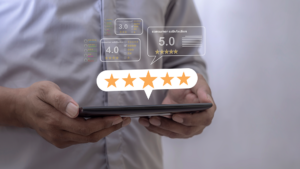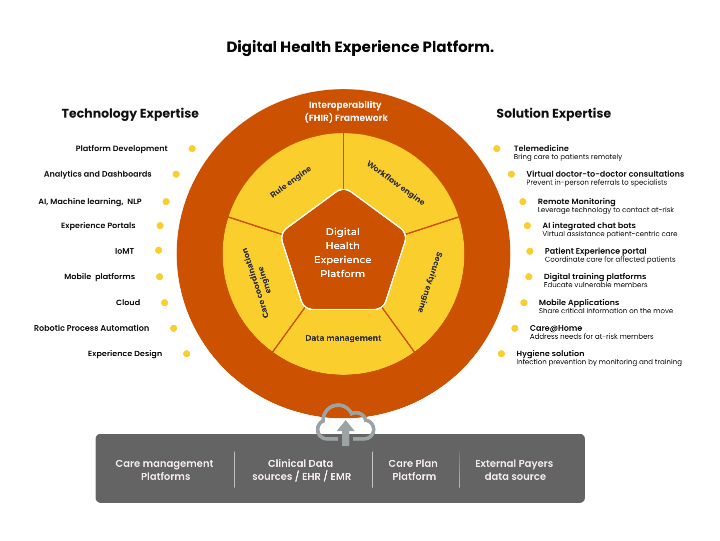


Renoj Raphael
11 Minutes read
How the COVID-19 Pandemic is Reshaping Digital Healthcare
The Corona virus outbreak has turned into a human tragedy, affecting millions of people worldwide. The global economy has anticipated severe results while the digital healthcare companies expect a breakthrough due to the unraveling Pandemic.
According to WHO, COVID-19 disease spreads faster if people don’t follow social distancing and maintain proper personal hygiene. Due to this healthcare industry is bound to observe many changes post the COVID wave, and the care industry should adapt to those changes to handle any such pandemic in the future digitally.
Transformation in the Point-of-care
During the months of the Corona crisis, the acceptance of patients for digital health solutions and services has increased drastically. The Healthcare industry expects increased recognition from patients as well as more favorable regulations for Digital health. Changing mindset and liberating data will change the characteristics of digital health, helping to improve adoption at scale. The adoption of digital health includes
- Increase in the use of Robots, chatbots to automate, and minimize patient contacts
- Remote examinations and monitoring
- Wearable, mobile device sensors, IR monitoring, Video/phone consultations
Connected Care
Digital healthcare platforms and solutions are connecting the care teams and patients to drive patient engagements to improve the treatment process.
Telemedicine
Telemedicine has played a crucial role during the Pandemic time by bringing care to patients, and the usage has increased exponentially as well. Telemedicine is a convenient method of care being delivered remotely from anywhere to manage chronic conditions, to cater to minor urgent care needs, to perform routine follow-up care, and for counseling services.
Virtual doctor-to-doctor consultation
Virtual doctor-to-doctor consultations may prevent unnecessary in-person referrals to a specialist. It reduces waiting time for specialists and eliminates unnecessary travel by providing specialized equipment through a video chat or a messaging service.
Remote monitoring
A variety of technologies that enables your doctors or care teams to monitor your health remotely. Health information is read and transmitted by updating manually in online portals or mobile apps, reading wirelessly from medical devices, and collecting data from wearable and for elderly residents using home monitoring devices. Caretakers remotely monitor blood pressure, blood glucose, heart rate, tremors, physical activity, and posture control.
Care@Home
Artificial Intelligence-based virtual assistance enables patients to have a remote consultation with the bot that has a massive volume of data. Chatbots automate your nutritional coaching after tracking calories and promote healthy eating habits. AI-based chatbots are built to provide drugs based information, health symptom, and all patient-centric care reminders and information.
Patient experience portal
Patient portals offer a secure means of transferring private medical information. Portals play a pivotal role in communicating with your doctor or and caretakers. From tracking and requesting the prescription refills to schedule your appointments and managing reminders with care providers, it’s a collaborative platform to engage the patients and guide them in their day-to-day activity. Portals play a crucial role in guiding the patients on reducing the number of infections, panic prevention, and improving mental health at the time of the pandemic.
Personal health records
A personal health record quickly provides emergency personnel with vital information, such as diagnoses, medications, drug allergies, and doctor contact information. It is accessible anytime and anywhere, via a web-enabled device, such as computer, laptop, tablet, or smartphone. Personal Health apps organize medical information digitally secured in one place.
AI and Robots
Upgrading the level of protection for healthcare professionals and patients is critical in emergencies. AI-based Robots reduce and manage workload and infection risks for doctors and caregivers. Using health monitoring devices, doctors and caregivers can monitor the patients’ health conditions. Robots help to deliver the prescriptions, food, and other hygiene products required for the hospitals.
Mobile Applications
Hospitals are extending HIS systems feature on the move with easy to use mobile applications for caregivers to track and monitor the patient’s medical data. The app will help doctors and caregivers to reduce data record activities and focus more on the care of patients.
Digital training platforms
Augmented reality and video storytelling techniques are introduced as part of the digital training solutions for caregivers. Employees can quickly access content from compliance checklists to boost engagement, improve clinical care, provide leadership training, and increase the mental health of the employees at the time of pandemics.
Hand hygiene solution
Around the world, the latest Pandemic highlights the importance of hygiene practices and infection prevention. Upgrading the hospital infection control is mainly classified into work path management and disinfection regulations. Evaluation of repeated monitoring and training to medical staff helps to avoid infection risk during transmission. WHO developed the Hand Hygiene Self-Assessment procedure Framework for the five moments of hand hygiene in facilities as part of the infection prevention campaign.
Sustainable supply chain solutions
The sustainable supply chain system will respond promptly to urgent needs and provide upstream the demands to procure medical supplies. Digitization in building end-to-end supply chain system includes hospital order placement, inventory warning systems, supplier acceptance, logistics, delivery and stock monitoring to ensure transparency and continuity.
Digital visitor management
In hospitals, traditional visitor management, staff attendance, and access are some of the most common issues/concerns at the time of any pandemic. Even at the time of COVID 19 usage of biometric attendance systems were discontinued. A sensor-based digital solution empowers your guests by allowing them to check-in through the comfort of their device, automating touchless and secure visitor management. The alert management system with real-time notification helps to trace the customers and victuals to individual needs.
Security and Interoperability
In healthcare organizations, privacy is a major concern when electronic health records (EHRs) send data across health IT systems. Data security is a challenge when it comes to sharing and receiving health records in a readable and useful manner for better patient care. Interoperability allows healthcare organizations to transfer health data securely.
Interoperability
Digital health transformation focuses on improving the quality of care, such as medical errors, cost optimization, and operational efficiency. The most significant disadvantage is the lack of integration and interoperability of health information among the providers, payers, pharmacies, and other stakeholders. How to achieve a seamless healthcare continuum? Data interoperability is the ability of the systems to communicate, share, and consume data. With Fast Healthcare Interoperability Resources (FHIR) and interoperability specification for the electronic exchange of health information is defined. The framework is built from a set of modular components called ‘Resources.’ The resources are the building blocks of FHIR, which consists of all the patient information. The users can request a query for specific resources as per their requirement, for instance, the payers can focus on the trend of claims and usage of particular procedure code across a set of the population like age, gender, and pieces of information.
Cybersecurity
Cybersecurity issues are pervasive across MedTech and the population health management platform. Companies need to embrace a security-by-design approach and establish real-time monitoring, cyber threat modeling and analysis, threat mitigation, and remediation. As part of Managed security services, integrated Security Orchestration, Automation, and Response (SOAR), Threat Intelligence Services, and User and Entity Behavior Analytics (UEBA) platforms provide advanced future threats predictions.
Internet of Medical Things (IoMT) and AI
The Internet of Medical Things boosts and bridges the gap between patient-provider engagement. Realizing the increasingly transformative nature of IoT technologies and advancements in wireless technology and 5G networking, the health care sector is all set to drive innovation in connected medical device development. The IoMT brings together people, data, processes, and enablers to efficiently deliver improved patient care outcomes. Connected medical devices and mobile applications help to bring together the patients, caregivers, and clinicians with patient or performance data in care delivery and patient support.
Population Health Management
Delivering population health platform improves the patient experience and quality of care by aggregating clinical data from multiple sources. It helps clients to improve interoperability and enable better coordination across the care continuum. Population digital platforms are built on data integration and aggregation engines, predictive analytics, AI and machine learning, actionable insights, and clean interactive dashboard. Digital experience platform with a robust and secure data aggregation engine provides unified user experience across the suite of applications used by payers, providers, government, and is flexible enough to meet stakeholders’ needs across the care continuum.
ACL Digital Health Experience Platform
ACL Digital is a pioneer in the healthcare industry and has been serving the healthcare community for about two decades now. Leveraging technologies like cloud, data, automation, AI, and our digital healthcare platform, we develop and manage intelligent and adaptable operating models for the healthcare industry. Spanning across the globe and having worked with all sorts of healthcare markets, we have a clear understanding of what is needed in the healthcare value chain that mainly consists of Patients, Payers, and Providers.

With our expertise in the healthcare industry, we have strategically assisted many healthcare IT vendors, especially in the USA, helping them to adapt to the latest technologies by modifying their work-flows, transitioning their system to the latest market needs and trends, and analyzing and predicting the future of the healthcare market and modifying their applications accordingly. Being in the industry for a substantial amount of time and working with a variety of healthcare clients has helped us gain exposure to almost all technologies, from the legacy system to the latest cutting-edge technology and programming languages. We have always been a proactive partner rather than a mere service provider.
Conclusion
The COVID-19 Pandemic has taught us several lessons. The year 2020 has turned out to be the decade of digital technology reshaping the global health system. The adoption of digital health has increased drastically which emphasizes on solutions built around telemedicine, virtual doctor-to-doctor consulting, remote care, connected care portals, and mobile apps. The pandemic crisis has once again reinforced the need and importance of monitoring and evaluating hygiene in the institutions, care workers, and patients. Digital technology providers are required to initiate innovations that enable the national policy, health data security, scalability, data governance, and technology infrastructure to transform the needs of providers, patients, and the public.
We are looking forward to implement the lessons learnt and the next steps in the process to transform digital health adoption and improvement in the quality of care.
ACL Digital has been a pioneer in the healthcare industry and has been serving the healthcare community for about two decades now. ACL is at the forefront of Digital Experience transformation and caters to healthcare industry globally. Feel free to get in touch with ACL Digital Consultants, if your business needs any help in building a roadmap and platform for digital transformation.




